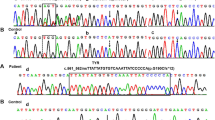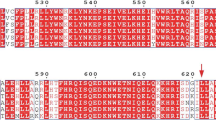Abstract
Oculocutaneous albinism (OCA) is a genetic disease characterized by the reduction or deficiency of melanin in eyes, skin, and hair. OCA exhibits genetic heterogeneity. Presently, there are four types of OCA named as OCA1, OCA2, OCA3, and OCA4. OCA3 is more common in African born blacks but rarely found in other ethnic populations. Our recent genotyping of patients with OCA of Chinese descent has identified two patients who were not OCA1, OCA2, or OCA4. Examination and analysis of the TYRP1 gene identified them to be having OCA3. PCR and DNA sequencing analysis found that the mutant TYPR1 alleles were present in each of the two patients, c.780-791del/c.1067G>A (p.R356Q) and c.625G>TT (p.G209LfsX1)/c.643C>T (p.H215Y). The c.780-791del and c.1067G>A mutations have been already reported. However, the c.625G>TT and c.643C>T mutations have not been previously reported and were found to be maternal and paternal mutations, respectively. Moreover, population screening and bioinformatic analysis were carried out to determine the effects of these two mutations which revealed that both the mutation were pathogenic. Based on the similar mild phenotype of these two patients, we suggest that OCA3 might be prevalent within the Chinese population.




Similar content being viewed by others
References
Suzuki, T., Inagaki, K., Fukai, K., Obana, A., Lee, S. T., & Tomita, Y. (2005). A Korean case of oculocutaneous albinism type IV caused by a D157 N mutation in the MATP gene. British Journal of Dermatology, 152, 174–175.
Grønskov, K., Ek, J., Sand, A., et al. (2009). Birth prevalence and mutation spectrum in Danish patients with autosomal recessive albinism. Investigative Ophthalmology & Visual Science, 50, 1058–1064.
Murty, V. V., Bouchard, B., Mathew, S., Vijayasaradhi, S., & Houghton, A. N. (1992). Assignment of the human TYRP (brown) locus to chromosome region 9p23 by nonradioactive in situ hybridization. Genomics, 13, 227–229.
Jimbow, K. (1999). Biological role of tyrosinase-related protein and its relevance to pigmentary disorders (vitiligo vulgaris). Journal of Dermatology, 26, 734–737.
Boissy, R. E., Zhao, H., Oetting, W. S., et al. (1996). Mutation in and lack of expression of tyrosinase-related protein-1 (TRP-1) in melanocytes from an individual with Brown oculocutaneous albinism: a new type of albinism classified as “OCA3”. American Journal of Human Genetics, 58, 1145–1156.
Manga, P., Kromberg, J. G., Box, N. F., Sturm, R. A., Jenkins, T., & Ramsay, M. (1997). Rufous oculocutaneous albinism in southern African Blacks is caused by mutations in the TYRP1 gene. American Journal of Human Genetics, 61, 1095–1101.
Forshew, T., Khaliq, S., Tee, L., et al. (2005). Identification of novel TYR and TYRP1 mutations in oculocutaneous albinism. Clinical Genetics, 68, 182–184.
Rooryck, C., Roudaut, C., Robine, E., Müsebeck, J., & Arveiler, B. (2006). Oculocutaneous albinism with TYRPl gene mutations in a Caucasian patient. Pigment Cell & Melanoma Research, 19, 239–242.
Rooryck, C., Morice-Picard, F., Elçioglu, N. H., Lacombe, D., Taieb, A., & Arveiler, B. (2008). Molecular diagnosis of oculocutaneous albinism: New mutations in the OCA1–4 genes and practical aspects. Pigment Cell & Melanoma Research, 21, 583–587.
Chiang, P. W., Spector, E., & Scheuerle, A. (2009). A case of Asian Indian OCA3 patient. American Journal of Medical Genetics Part A, 149A, 1578–1580.
Hongyi, L., Haiyun, W., Hui, Z., et al. (2007). Prenatal diagnosis of oculocutaneous albinism type II and novel mutations in two Chinese families. Prenatal Diagnosis, 27, 502–506.
Eswar, N., Webb, B., Marti-Renom, M. A. et al. (2006). Comparative protein structure modeling using Modeller. Current Protocols in Bioinformatics, Chapter 5, Unit 5.6.
Kromberg, J. G., Castle, D. J., Zwane, E. M., et al. (1990). Red or rufous albinism in Southern Africa. Ophthalmic Paediatrics and Genetics, 11, 229–235.
Wei, A., Wang, Y., Long, Y., et al. (2010). A comprehensive analysis reveals mutational spectra and common alleles in Chinese patients with oculocutaneous albinism. Journal of Investigative Dermatology, 130, 716–724.
Acknowledgments
We thank the patients and their families for participation in the study. We also thank the National Natural Science Foundation of China (Grant #30672003), Medical Research Foundation of Guangdong Province of China (Grant #A2009351), and Natural Science Foundation of Guangdong Province of China (Grant #04009328) for financial support.
Author information
Authors and Affiliations
Corresponding authors
Additional information
Kai-hui Zhang and Zhuo Li contributed equally to this study.
Rights and permissions
About this article
Cite this article
Zhang, Kh., Li, Z., Lei, J. et al. Oculocutaneous Albinism Type 3 (OCA3): Analysis of Two Novel Mutations in TYRP1 Gene in Two Chinese Patients. Cell Biochem Biophys 61, 523–529 (2011). https://doi.org/10.1007/s12013-011-9234-0
Published:
Issue Date:
DOI: https://doi.org/10.1007/s12013-011-9234-0




